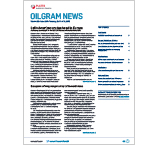S&P Global Offerings
Featured Topics
Featured Products
Events
S&P Global Offerings
Featured Topics
Featured Products
Events
S&P Global Offerings
Featured Topics
Featured Products
Events
S&P Global Offerings
Featured Topics
Featured Products
Events
Our Methodology
Methodology & Participation
Reference Tools
S&P Global
S&P Global Offerings
S&P Global
Research & Insights
Our Methodology
Methodology & Participation
Reference Tools
S&P Global
S&P Global Offerings
S&P Global
Research & Insights
20 Nov 2015 | 10:31 UTC — Insight Blog
Featuring Christine Forster
Three years ago I blogged on The Barrel how Caltex Australia was breaking the mold in the traditionally male-dominated refining industry by launching the nation's most generous workplace support package for new parents.
In 2015, Caltex's willingness to show its feminine side through its "BabyCare" scheme appears to have paid dividends. Not only has the program helped Caltex win a gender equality citation from the Australian government's Workplace Gender Equality Agency, the company is now reporting a 25% increase in the number of women transitioning back to work and developing their careers after having a baby.
A lot has changed for Caltex since BabyCare was launched in 2012. Back then, the company operated two oil refineries on Australia's east coast and was 50%-owned by US major Chevron. Now, it operates just one refinery, its 109,000 b/d plant at Lytton in Brisbane, having converted its 135,000 b/d facility at Kurnell in Sydney into an import terminal in October 2014.
Caltex's ownership structure has also been transformed by Chevron's decision in March this year to sell out of the Australian downstream sector. Chevron made A$4.7 billion ($3.3 billion) from the sale of its half share of Caltex, leaving the refiner/marketer entirely in the hands of its Australian shareholders.
The balance of male and female employees at Caltex has also changed over the past three years. In 2012, about 70% of the company's employees were male, but today the figure is 63%.
"Caltex has taken some big strides in terms of improving its gender equality over recent years, but our journey continues," according to the company's head of capability, performance and reward Alena Mackie. "We are particularly pleased with our negligible gender pay differential of 1.1% on a like-for-like basis and the significant progress that we're making towards our goal to increase the number of female senior leaders across our organization."
In 2013, one in every five senior leaders at Caltex was female. "We reached our goal of improving this to one in four last year and are now on track to make it one in three in 2016," Mackie said.
Caltex is achieving the milestones by strengthening its senior female talent pipeline through the provision of development and promotion opportunities, and continuously monitoring "key gender metrics."
Blog post continues below...
|
|
||||
| Request a free trial of: Oilgram News |  |
|||
 |
Oilgram News brings fast-breaking global petroleum and gas news to your desktop every day. Our extensive global network of correspondents report on supply and demand trends, corporate news, government actions, exploration, technology, and much more. | |||
 |
||||
|
|
||||
But what hasn't changed is Caltex's unique position as a provider of financial and practical support for parents who are returning to work after the birth of a child. Caltex's BabyCare package goes far beyond corporate Australia's usual provision of paid leave for employees just before and after a birth.
The scheme provides workers who are the primary care-giver a quarterly bonus amounting to 3% of their base salary, or 12% annually, up until the child's second birthday. It also offers payments of around A$1,500 for emergency childcare through a service which provides nannies and mothercraft nurses.
The payments are on top of the company's existing provisions for 12 calendar weeks full pay or 24 calendar weeks half pay for birth mothers, and eight calendar weeks full pay or 16 weeks half pay for non-birth parents.
The aim of the package is to remove obstacles for parents who want to return to work at Caltex after the birth of a child, a company spokesman said. "The key is providing options for those who want to come back," he added.
"We're not aware of any other companies that provide the same financial and practical support," the spokesman said. "We also seek to provide returning parents with flexible work arrangements and most of our returning parents tend to return to work on a part-time basis," he added.
"While some companies in the broader market also provide childcare assistance, we know through discussions that many face challenges in doing this on a national and consistent basis. Our BabyCare package simply addresses this challenge through the financial support and childcare search assistance that we provide. In this way, the parent has the support they need to find childcare solutions that are appropriate for their specific circumstances."
So far the program has been a huge success, with the number of parents returning to work now at 100%, up from around 80% previously, the spokesman said. And of those returning, only one has chosen not to remain at the company after 12 months, which is by any measure an impressive result.